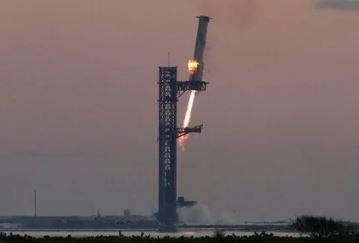SpaceX achieved a significant milestone on Sunday by not only launching a 233-foot rocket booster but also successfully catching it mid-air with two massive mechanical arms. This achievement took place during the fifth test flight of the Starship rocket and marked a major advancement in SpaceX’s long-term goal of transporting humans to Mars. In the nearer term, SpaceX is under a $4 billion contract with NASA to use Starship for two lunar missions as part of the Artemis program.
Elon Musk’s company has built and flown the largest and most powerful rocket in the world, and now it has demonstrated a key technology to make the Starship fully reusable. This capability allows the rocket to be relaunched frequently, akin to how airplanes operate, instead of requiring a new rocket for each flight. NASA administrator Bill Nelson congratulated SpaceX for this success on the social media platform X, noting that it brings humanity closer to the bold missions ahead, including returning to the Moon and eventually landing on Mars.
The flight took off at 8:25 a.m. Eastern Time from SpaceX’s launch site near Brownsville, Texas. The Starship vehicle, stacked atop the Super Heavy booster, is designed to carry more than 100 metric tons into orbit. After the booster powered the Starship through the thickest part of the atmosphere, it detached and the Starship continued toward space. Meanwhile, the booster reignited several of its engines to guide itself back to the launch site, where it was caught by mechanical arms, affectionately called “chopsticks.” The booster’s descent, however, shook the region, with some residents as far as 40 miles away reporting that their houses vibrated as if during a small earthquake.
Gwynne Shotwell, SpaceX’s chief operating officer, expressed her amazement on X, marveling at the precision of the booster’s return. Although a small fire flared at the base of the booster, it was quickly extinguished.
The booster’s return mimicked how SpaceX already recovers Falcon 9 rocket stages, but the Falcon 9 stages still need to be transported back to the launch site. In contrast, Starship boosters will be able to land directly at the launch site and be ready for rapid reuse. SpaceX has designed the launch tower with the capability to catch not only the booster but also the Starship vehicle upon its return from orbit.
While the booster was successfully caught, the upper-stage Starship vehicle continued its journey into space, targeting the Indian Ocean. Though SpaceX was not planning to recover this vehicle, it performed a controlled landing on water before exploding. The controlled descent demonstrated improved thermal protection that Starship needs to survive re-entry, essential for future missions to Mars or the Moon.
Despite the technical success, the launch raised environmental concerns. The Federal Aviation Administration (FAA) had approved the test after months of delays, partly due to environmental concerns. Some residents and environmentalists have expressed worry over the sonic booms and potential ecological damage caused by the launches. SpaceX is required to study the impact of rocket-launched debris on local wildlife, with plans to use drones equipped with infrared cameras to monitor bird nesting sites.
SpaceX is seeking approval to increase the number of launches at its Texas site from five to 25 annually, but there are concerns about the potential for property and wildlife damage. After Sunday’s test, the FAA will conduct post-flight inspections to assess any impact on nearby homes and structures. While some residents reported stronger vibrations and louder sonic booms during this launch compared to previous ones, others, like Keith Reynolds, who lives just four miles from the launch site, said the noise and vibrations felt similar to earlier flights. Reynolds described the event as “an incredible feat” and expressed enthusiasm for future launches.
Elon Musk has set ambitious goals for Starship, aiming for the first crewed missions to Mars as soon as 2026. However, significant challenges remain, including refining Starship’s ability to refuel in orbit and scaling up the frequency of launches. Nevertheless, SpaceX’s latest success brings humanity one step closer to the next era of space exploration.

